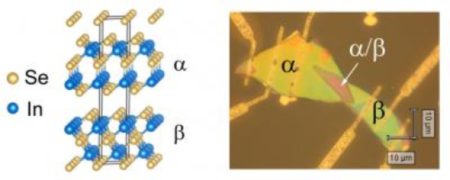Sep
5
New Device Turns Heat Into Electrical Energy
September 5, 2017 | 9 Comments
The device is a multicomponent, multilayered composite material called a van der Waals Schottky diode. It converts heat into electricity up to three times more efficiently than silicon – a semiconductor material widely used in the electronics industry. The new device is being developed by Washington State University physicist Yi Gu.

The left panel shows the schematic lattice structures of the alpha-beta In2Se3 van der Waals metal-semiconductor junction, and the right panel shows an optical micrograph of a junction device. Image Credit: Yi Gu. Click image for the largest view.
While still in an early stage of development, the new diode could eventually provide an extra source of power for everything from smartphones to automobiles.
Gu, an associate professor in WSU’s Department of Physics and Astronomy said, “The ability of our diode to convert heat into electricity is very large compared to other bulk materials currently used in electronics. In the future, one layer could be attached to something hot like a car exhaust or a computer motor and another to a surface at room temperature. The diode would then use the heat differential between the two surfaces to create an electric current that could be stored in a battery and used when needed.”
In the world of electronics, Schottky diodes are used to guide electricity in a specific direction, similar to how a valve in a water main directs the flow of liquid going through it. They are made by attaching a conductor metal like aluminum to a semiconductor material like silicon.
Instead of combining a common metal like aluminum or copper with a conventional semiconductor material like silicon, Gu’s diode is made from a multilayer of microscopic, crystalline indium selenide (In2Se3). He and a team of graduate students used a simple heating process to modify one layer of the indium selenide to act as a metal and another layer to act as a semiconductor. The researchers then used a new kind of confocal microscope developed by Klar Scientific, a start-up company founded in part by WSU physicist Matthew McCluskey, to study their materials’ electronic properties.
Unlike its conventional counterparts, Gu’s diode has no impurities or defects at the interface where the metal and semiconductor materials are joined together. The smooth connection between the metal and semiconductor enables electricity to travel through the multilayered device with almost 100 percent efficiency.
McCluskey, a co-author of the study said, “When you attach a metal to a semiconductor material like silicon to form a Schottky diode, there are always some defects that form at the interface. These imperfections trap electrons, impeding the flow of electricity. Gu’s diode is unique in that its surface does not appear to have any of these defects. This lowers resistance to the flow of electricity, making the device much more energy efficient.”
Gu and his collaborators are currently investigating new methods to increase the efficiency of their indium selenide crystals. They are also exploring ways to synthesize larger quantities of the material so that it can be developed into useful devices.
Gu added, “While still in the preliminary stages, our work represents a big leap forward in the field of thermoelectrics. It could play an important role in realizing a more energy-efficient society in the future.”
Without some idea of the efficacy and efficiency the celebration will have to wait. But by any description any increase in harvesting heat is welcome. Most energy used is lost to heat somewhere along the line. Recovery, salvaging, harvesting or however the choice in term is made, using the energy lost of heat is a very big target. Perhaps now we can hope there is a device that be developed to make a dent or hopefully a big chuck of the loss can be put back to work.
Comments
9 Comments so far


It converts heat into electricity up to three times more efficiently than silicon – a semiconductor material widely used in the electronics industry. The new device is being developed by Washington State University physicist Yi Gu.It sounds great, and hoping more and more methods can be developed to help us get new energy.
Recovery, salvaging, harvesting or however the choice in term is made, using the energy lost of heat is a very big target. Perhaps now we can hope there is a device that be developed to make a dent or hopefully a big chuck of the loss can be put back to work.
Without some idea of the efficacy and efficiency the celebration will have to wait. But by any description any increase in harvesting heat is welcome. Most energy used is lost to heat somewhere along the line.
Hope this new device will be put into use as soon as possible.
The new device to turn heat into electricity is environmental project and should be promoted.
The new diode must have a grand prospect in the future. Because the smooth connection between the metal and semiconductor enables electricity to travel through the multilayered device with almost 100 percent efficiency.
Good device, it is benecial to sustainable development.
New device sounds great! Hope this new device will be promoted all over the world.
A very good article, more people can see the news.